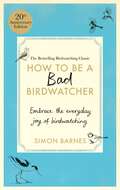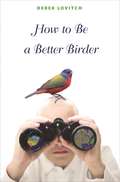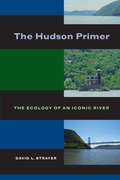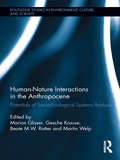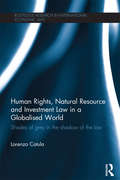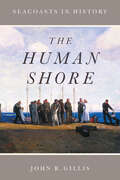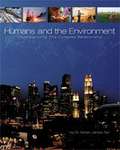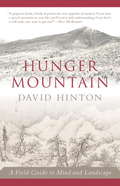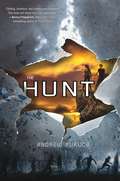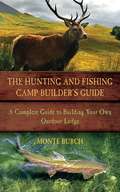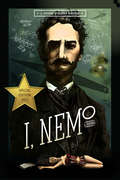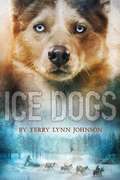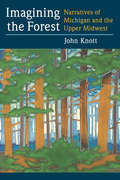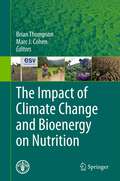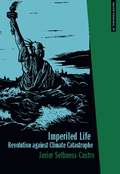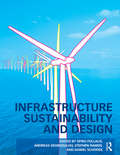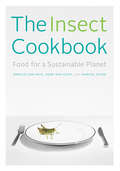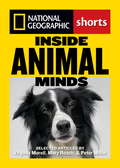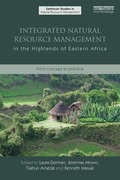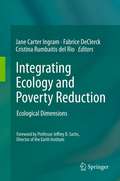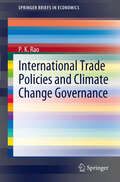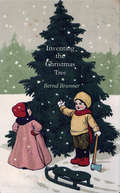- Table View
- List View
How to be a Bad Birdwatcher: To The Greater Glory Of Life
by Simon BarnesLook out of the window. See a bird. Enjoy it. Congratulations. You are now a bad birdwatcher. Anyone who has ever gazed up at the sky or stared out of the window knows something about birds. In this funny, inspiring, eye-opening book, Simon Barnes paints a riveting picture of how bird-watching has framed his life and can help us all to a better understanding of our place on this planet. How to be a bad birdwatcher shows why birdwatching is not the preserve of twitchers, but one of the simplest, cheapest and most rewarding pastimes around.
How to Be a Better Birder
by Derek LovitchThe essential tools you need to become a better birderThis unique illustrated handbook provides all the essential tools you need to become a better birder. Here Derek Lovitch offers a more effective way to go about identification—he calls it the "Whole Bird and More" approach—that will enable you to identify more birds, more quickly, more of the time. He demonstrates how to use geography and an understanding of habitats, ecology, and even the weather to enrich your birding experience and help you find something out of the ordinary. Lovitch shows how to track nocturnal migrants using radar, collect data for bird conservation, discover exciting rarities, develop patch lists—and much more.This is the ideal resource for intermediate and advanced birders. Whether you want to build a bigger list or simply learn more about birds, How to Be a Better Birder will take your birding skills to the next level.Explains the "Whole Bird and More" approach to bird identificationDemonstrates how to use geography, habitats, ecology, and the weather to be a better birderShows how to bird at night using radar, collect conservation data, develop patch lists—and moreOffers essential tools for intermediate and advanced birders
The Hudson Primer: The Ecology of an Iconic River
by David L. StrayerThis succinct book gives an intimate view of the day-to-day functioning of a remarkable river that has figured prominently in history and culture--the Hudson, a main artery connecting New York, America, and the world. Writing for a wide audience, David Strayer distills the large body of scientific information about the river into a non-technical overview of its ecology. Strayer describes the geography and geology of the Hudson and its basin, the properties of water and its movements in the river, water chemistry, and the river's plants and animals. He then takes a more detailed look at the Hudson's ecosystems and each of its major habitats. Strayer also discusses important management challenges facing the river today, including pollution, habitat destruction, overfishing, invasive species, and ecological restoration.
Human-Nature Interactions in the Anthropocene: Potentials of Social-Ecological Systems Analysis (Routledge Studies in Environment, Culture, and Society)
by Gesche Krause Beate M.W. Ratter Marion Glaser Martin Welp Andrew HallidayThis book deals with the potentials of social-ecological systems analysis for resolving sustainability problems. Contributors relate inter- and transdisciplinary perspectives to systemic dynamics, human behavior and the different dimensions and scales. With a problem-focused, sustainability-oriented approach to the analysis of human-nature relations, this text will be a useful resource for scholars of human and social ecology, geography, sociology, development studies, social anthropology and natural resources management.
Human Rights, Natural Resource and Investment Law in a Globalised World: Shades of Grey in the Shadow of the Law (Routledge Research in International Economic Law)
by Lorenzo CotulaIn the world’s developing countries, foreign investment in natural resources brings into contact competing interests that are often characterised by unequal balances of negotiating power – from multinational corporations and host governments, through to the local people affected by the influx of foreign investment. The growing integration of the world economy has been accompanied by rapid and extensive developments in the national and international norms that regulate investment and its impact – including investment law, natural resource law and human rights law. These legal developments affect the ‘shadow’ that the law casts over the multiple negotiations that characterise international investment projects in the developing world. Drawing on international law, the national law of selected jurisdictions and the contracts concluded in a large investment project, Human Rights, Natural Resource and Investment Law in a Globalised World explores the ways in which the law protects the varied property rights that are at play in foreign investment projects in developing countries, with a focus on Africa. Through an integrated analysis of seemingly disparate fields of law, this book sheds new light on how the law mediates the competing interests that come into contact as a result of economic globalisation, whilst also providing new insights on the changing nature of state sovereignty and on the relationship between law and power in a globalised world. This book will be of interest to scholars, students and informed practitioners working in the fields of international investment and human rights law, comparative law, socio-legal studies, and development studies.
The Human Shore: Seacoasts in History
by John R. GillisSince before recorded history, people have congregated near water. But as growing populations around the globe continue to flow toward the coasts on an unprecedented scale and climate change raises water levels, our relationship to the sea has begun to take on new and potentially catastrophic dimensions. The latest generation of coastal dwellers lives largely in ignorance of the history of those who came before them, the natural environment, and the need to live sustainably on the world's shores. Humanity has forgotten how to live with the oceans. In The Human Shore, a magisterial account of 100,000 years of seaside civilization, John R. Gillis recovers the coastal experience from its origins among the people who dwelled along the African shore to the bustle and glitz of today's megacities and beach resorts. He takes readers from discussion of the possible coastal location of the Garden of Eden to the ancient communities that have existed along beaches, bays, and bayous since the beginning of human society to the crucial role played by coasts during the age of discovery and empire. An account of the mass movement of whole populations to the coasts in the last half-century brings the story of coastal life into the present. Along the way, Gillis addresses humankind's changing relationship to the sea from an environmental perspective, laying out the history of the making and remaking of coastal landscapes--the creation of ports, the draining of wetlands, the introduction and extinction of marine animals, and the invention of the beach--while giving us a global understanding of our relationship to the water. Learned and deeply personal, The Human Shore is more than a history: it is the story of a space that has been central to the attitudes, plans, and existence of those who live and dream at land's end.
Humans and the Environment: Understanding This Complex Relationship
by Adrian James TanThis introduction to sociology examines the complex relationship between humans and the environment and how this relationship changes over time, with technology as the catalyst.
Hunger Mountain: A Field Guide to Mind and Landscape
by David HintonLearning to see with the eyes of the ancient Chinese sages can change your view of the universe, as David Hinton demonstrates. He takes us on a series of walks up Hunger Mountain, a wilderness area near his home in Vermont. What he sees and describes about these outings is informed by the cosmos-view he's imbibed from his many years of translating Chinese poetry: a way of looking at nature, and our place in it, and a particular way of regarding the relationship between ourselves and the universe. It's a view that informs all the great Chinese poetry and art. It's found in Taoism and Chinese expressions of Buddhism, but it predates them by millennia, going back probably to the Paleolithic Age--and it's found in the structures of the Chinese language itself, and in the evolution of the system of writing. Each chapter takes its name and theme from a character of the Chinese alphabet, whose history and development Hinton examines. They originate as primitive marks, very literally expressing the simplest of ideas, from which they grow and develop through time to express concepts of great subtlety. The poets and artists understood this and kept their focus on the emptiness that gives birth to all things as they used language and images that sprang from that emptiness. We learn about this as David walks up and around Hunger Mountain, making observations about the landscape, his place in it, and the underlying geological reality, telling stories of the great poets as he goes. It's the profoundest kind of nature writing, and it's an exceptionally accessible entrée to an ancient Chinese view of the universe.
The Hunt (Hunt Trilogy #1)
by Andrew FukudaDon't Sweat. Don't Laugh. Don't draw attention to yourself. And most of all, whatever you do, do not fall in love with one of them. Gene is different from everyone else around him. He can't run with lightning speed, sunlight doesn't hurt him and he doesn't have an unquenchable lust for blood. Gene is a human, and he knows the rules. Keep the truth a secret. It's the only way to stay alive in a world of night―a world where humans are considered a delicacy and hunted for their blood. When he's chosen for a once in a lifetime opportunity to hunt the last remaining humans, Gene's carefully constructed life begins to crumble around him. He's thrust into the path of a girl who makes him feel things he never thought possible―and into a ruthless pack of hunters whose suspicions about his true nature are growing. Now that Gene has finally found something worth fighting for, his need to survive is stronger than ever―but is it worth the cost of his humanity?
The Hunting and Fishing Camp Builder's Guide: A Complete Guide to Building Your Own Outdoor Lodge
by Monte BurchThere cannot be a hunter and angler who has not, at some time or other, daydreamed about building his or her own camp. Hunting & Fishing Camp Builder's Guide provides the concepts, plans, and know-how to turn a daydream into a reality. Monte Burch applies decades of how-to skills to describe the "ins and outs" of design and construction. From the cabin to the furniture inside, you can do it all yourself and create the camp or lodge of your dreams.
I, Nemo
by J. Dharma Windham Deanna WindhamWhat if the Nautilus and its famous captain wasn't fiction?Every legend has a beginning. Every man has a name. But none as dark and mysterious as the depths of the seas he stalked. The world in time would come to know him as Captain Nemo and his fabulous submarine the Nautilus. Here, for the first time, the tale is told in his own words of how he came to be: I, NemoBorn Jonathan de Chevalier Mason, he had it all: a prestigious position as chief naval engineer to Queen Victoria, a beautiful wife and children, and a bright future, but he was betrayed by the very people he served and loved because he would not divulge the secret of a weapon so terrible that whoever possessed it would rule the world. Thus begins a sordid and shocking ordeal unsurpassed in history. Arrested on false charges and tried in the Star Chamber, a secret court, he is convicted and sent to Belial Island to toil endlessly in its steaming tropical jungles. Then fortune smiles on him in the guise of a frail elderly French priest and his little band of followers. Together the two men hatch a plot to escape and forever be free of tyrannical governments that cast them aside like trash. But Jonathan has a score to settle and soon his betrayers will feel his wrath.I, Nemo is a steampunk novel written in Dharma and Deanna's signature style, historical fact blending seamlessly with fiction, it is an action packed, gut wrenching roller coaster ride of torrential proportions. Starting with 20,000 Leagues Under the Sea, J. Dharma & Deanna Windham have added greater depth and vibrancy to this time honored classic, creating something altogether unique and different.
Ice Dogs
by Terry Lynn JohnsonVictoria Secord, a fourteen-year-old Alaskan dogsled racer, loses her way on a routine outing with her dogs. With food gone and temperatures dropping, her survival and that of her dogs and the mysterious boy she meets in the woods is entirely up to her. The author Terry Lynn Johnson is a musher herself, and her crackling writing puts readers at the reins as Victoria and Chris experience setbacks, mistakes, and small triumphs in their wilderness adventure.
Imagining the Forest // Narratives of Michigan and the Upper Midwest
by John Knott"Forests have always been more than just their trees. The forests in Michigan (and similar forests in other Great Lakes states such as Wisconsin and Minnesota) played a role in the American cultural imagination from the beginnings of European settlement in the early 19th century to the present. Our relationships with those forests have been shaped by the cultural attitudes of the times, and people have invested in them both moral and spiritual meanings. Author John Knott draws upon such works as Simon Schama's Landscape and Memory and Robert Pogue Harrison's Forests: The Shadow of Civilization in exploring ways in which our relationships with forests have been shaped, using Michigan-its history of settlement, popular literature, and forest management controversies-as an exemplary case. Knott looks at such well-known figures as William Bradford, James Fenimore Cooper, John Muir, John Burroughs, and Teddy Roosevelt; Ojibwa conceptions of the forest and natural world (including how Longfellow mythologized them); early explorer accounts; and contemporary literature set in the Upper Peninsula, including Jim Harrison's True North and Philip Caputo's Indian Country. Two competing metaphors evolved over time, Knott shows: the forest as howling wilderness, impeding the progress of civilization and in need of subjugation, and the forest as temple or cathedral, worthy of reverence and protection. Imagining the Forest shows the origin and development of both"--
The Impact of Climate Change and Bioenergy on Nutrition
by Marc J Cohen Brian ThompsonClimate changes will affect food production in a number of ways. Crop yields, aquatic populations and forest productivity will decline, invasive insect and plant species will proliferate and desertification, soil salinization and water stress will increase. Each of these impacts will decrease food and nutrition security, primarily by reducing access to and availability of food, and also by increasing the risk of infectious disease. Although increased biofuel demand has the potential to increase incomes among producers, it can also negatively affect food and nutrition security. Land used for cultivating food crops may be diverted to biofuel production, creating food shortages and raising prices. Accelerations in unregulated or poorly regulated foreign direct investment, deforestation and unsustainable use of chemical fertilizers may also result. Biofuel production may reduce women's control of resources, which may in turn reduce the quality of household diets. Each of these effects increases risk of poor food and nutrition security, either through decreased physical availability of food, decreased purchasing power, or increased risk of disease. The Impact of Climate Change and Bioenergy on Nutrition articulates the links between current environmental issues and food and nutrition security. It provides a unique collection of nutrition statistics, climate change projections, biofuel scenarios and food security information under one cover which will be of interest to policymakers, academia, agronomists, food and nutrition security planners, programme implementers, health workers and all those concerned about the current challenges of climate change, energy production, hunger and malnutrition.
Imperiled Life
by Javier SethnessImperiled Life theorizes an exit from the potentially terminal consequences of capital-induced climate change. It is a collection of reflections on the phenomenon of catastrophe--climatological, political, social--as well as on the possibilities of overcoming disaster. Javier Sethness-Castro presents the grim news from contemporary climatologists while providing a reconstructive vision inspired by anarchist intellectual traditions and promoting critical thought as a means of changing our historical trajectory. Javier Sethness-Castro is a libertarian socialist and a rights advocate. Imperiled Life is his first book.
Infrastructure Sustainability and Design
by Spiro Pollalis Andreas Georgoulias Stephen Ramos Daniel SchodekYou're overseeing a large-scale project, but you're not an engineering or construction specialist, and so you need an overview of the related sustainability concerns and processes. To introduce you to the main issues, experts from the fields of engineering, planning, public health, environmental design, architecture, and landscape architecture review current sustainable large-scale projects, the roles team members hold, and design approaches, including alternative development and financing structures. They also discuss the challenges and opportunities of sustainability within infrastructural systems, such as those for energy, water, and waste, so that you know what's possible. And best of all, they present here for the first time the Zofnass Environmental Evaluation Methodology guidelines, which will help you and your team improve infrastructure design, engineering, and construction.
The Insect Cookbook: Food for a Sustainable Planet (Arts and Traditions of the Table: Perspectives on Culinary History)
by Arnold van Huis Henk van Gurp Marcel DickeThe Definitive Guide to Insects as a Sustainable Food SourceIn The Insect Cookbook, two entomologists and a chef make the case for insects as a sustainable source of protein for humans and a necessary part of our future diet. They provide consumers and chefs with the essential facts about insects for culinary use, with recipes simple enough to make at home yet boasting the international flair of the world's most chic dishes."Invite politicians to dinner and let them tell the world how delicious it is.... They will proudly go around and say, 'I ate crickets, I ate locusts, and they were delicious.'"—Kofi Annan The Insect Cookbook features delicious recipes and interviews with top chefs, insect farmers, political figures, and nutrition experts, including chef René Redzepi, whose establishment was elected three times as "best restaurant of the world"; Kofi Annan, former secretary-general of the United Nations; and Daniella Martin of Girl Meets Bug. The book contains all you need to know about cooking with insects, where to buy them, which ones are edible, and how to store and prepare them at home and in commercial spaces.
The Insect Cookbook
by Françoise Takken-Kaminker Arnold Van Huis Henk Van Gurp Marcel Dicke Diane Blumenfeld-SchaapInsects will be appearing on our store shelves, menus, and plates within the decade. In The Insect Cookbook, two entomologists and a chef make the case for insects as a sustainable source of protein for humans and a necessary part of our future diet. They provide consumers and chefs with the essential facts about insects for culinary use, with recipes simple enough to make at home yet boasting the international flair of the world's most chic dishes.Insects are delicious and healthy. A large proportion of the world's population eats them as a delicacy. In Mexico, roasted ants are considered a treat, and the Japanese adore wasps. Insects not only are a tasty and versatile ingredient in the kitchen, but also are full of protein. Furthermore, insect farming is much more sustainable than meat production. The Insect Cookbook contains delicious recipes; interviews with top chefs, insect farmers, political figures, and nutrition experts (including chef René Redzepi, whose establishment was elected three times as "best restaurant of the world"; Kofi Annan, former secretary-general of the United Nations; and Daniella Martin of Girl Meets Bug); and all you want to know about cooking with insects, teaching twenty-first-century consumers where to buy insects, which ones are edible, and how to store and prepare them at home and in commercial spaces.
Inside Animal Minds: The New Science of Animal Intelligence
by Mary Roach Virginia MorellVirginia Morell provides an overview of the science of animal intelligence. She introduces you to an African gray parrot named Alex, a bonobo named Kanzi, and a border collie named Betsy. Each of these animals tells us something interesting about the way they perceive and manipulate their world. The article also looks at what scientists are learning about the intelligence of dolphins and crows, beyond mere communication. Mary Roach takes us to the savannahs of Senegal to meet a group of 34 chimpanzees, whose behavior and social structures have given scientists some important clues about the nature of their communication and intelligence. Peter Miller looks at the collective behavior of ants, bees, and other insects for what they can tell us about social organization and how sometimes intelligence lies outside of the individual brain. This article served as the basis for his book, The Smart Swarm: How Understanding Flocks, Schools, and Colonies Can Make Us Better at Communicating, Decision Making, and Getting Things Done.
Integrated Natural Resource Management in the Highlands of Eastern Africa: From Concept to Practice (Earthscan Studies in Natural Resource Management)
by Laura German Jeremias Mowo Tilahun Amede Kenneth MasukiThis book documents a decade of research, methodological innovation, and lessons learned in an eco-regional research-for-development program operating in the eastern African highlands, the African Highlands Initiative (AHI). It does this through reflections of the protagonists themselves—AHI site teams and partners applying action research to development innovation as a means to enhance the impact of their research. The book summarizes the experiences of farmers, research and development workers and policy and decision-makers who have interacted within an innovation system with the common goal of implementing an integrated approach to natural resource management (NRM) in the humid highlands. This book demonstrates the crucial importance of "approach" in shaping the outcomes of research and development, and distils lessons learned on what works, where and why. It is enriched with examples and case studies from five benchmark sites in Ethiopia, Uganda, Kenya and Tanzania, whose variability provides the reader with an in-depth knowledge of the complexities of integrated NRM in agro-ecosystems that play an important role in the rural economy of the region. It is shown that the struggle to achieve sustainable agricultural development in challenging environments is a complex one, and can only be effectively achieved through combined efforts and commitment of individuals and institutions with complementary roles.
Integrating Ecology and Poverty Reduction: Ecological Dimensions
by Cristina Rumbaitis del Rio Fabrice Declerck Jane Carter IngramIn the past, the science of ecology has frequently been excluded from the development agenda for various reasons. Increasingly however there has been a renewed interest in finding more ecologically sustainable means of development that have required a strong foundation in ecological knowledge (for example EcoAgriculture Partnerships, EcoHealth presented at ESA, and EcoNutrition proposed by Deckelbaum et al). Each of these examples has already taken the critical first step at integrating ecological knowledge with agriculture, health and nutrition, respectively. However, this is only the first step; more attention needs to be placed not only on the role that two fields can play towards poverty alleviation, but on the role of a truly integrated, interdisciplinary approach towards development goals that is firmly grounded in ecological understanding. We feel that a critical look at what ecology can and cannot provide to the development agenda, in light of the Millennium Development goals, is timely and crucial. The introduction and the final section of the book will then integrate the lessons and principles outlined in each of the chapters. All chapter authors will be heavily encouraged to focus on how their sub-discipline in ecology impacts overall human well-being and environmental sustainability.
International Trade Policies and Climate Change Governance
by P. K. RaoThis work offers a synthesis of the current approaches toward an integration of international trade and climate change, with a view to fostering potential improvements in policies and institutions affecting these. A number of pragmatic measures are proposed with reference to the WTO and the United Nations Framework Convention on Climate Change (UNFCCC) regimes, which are expected to contribute toward enhanced climate change governance, as well as promoting international trade.
Introduction to Modern Climate Change
by Andrew E. DesslerThis textbook is tightly focused on the problem of anthropogenic climate change. It is unique among textbooks on climate change in that it combines an introduction of the science with an introduction to the non-science issues such as the economic and policy options. Unlike more purely descriptive textbooks, it contains the quantitative depth that is necessary for an adequate understanding of the science of climate change. The goal of the book is for a student to leave the class ready to engage in the public policy debate on this issue. This is an invaluable textbook for any introductory survey course on the science and policy of climate change, for both non-science majors and introductory science students.
Introduction to the Physical and Biological Oceanography of Shelf Seas
by John H. Simpson Jonathan SharplesIn this exciting and innovative textbook, two leading oceanographers bring together the fundamental physics and biology of the coastal ocean in a quantitative but accessible way for undergraduate and graduate students. Shelf sea processes are comprehensively explained from first principles using an integrated approach to oceanography that helps build a clear understanding of how shelf sea physics underpins key biological processes in these environmentally sensitive regions. Using many observational and model examples, worked problems and software tools, the authors explain the range of physical controls on primary biological production and shelf sea ecosystems. Boxes throughout the book present extra detail for each topic and non-mathematical summary points are provided for physics sections, allowing students to develop an intuitive understanding. The book is fully supported by extensive online materials, including worked solutions to end-of-chapter exercises, additional homework/exam problems with solutions and simple MATLAB and FORTRAN models for running simulations.
Inventing the Christmas Tree
by Benjamin A. Smith Bernd BrunnerA colorfully decorated Christmas tree, lit with twinkling lights, provokes awe and delight. We understand the lighted tree as a central symbol of the Christmas season, but what are the roots of the tradition? Who first thought to bedeck a tree, to bring it inside? How and where did the local activity grow into a widespread tradition, and how has the Christmas tree traveled across time and continents? Bernd Brunner's brief history--enriched by a selection of delightful and unusual historical illustrations--spans many centuries and cultures to illuminate the mysteries of the Christmas tree and its enduring hold on the human imagination. Tracing various European traditions from the Middle Ages forward, Brunner finds that only in the nineteenth century did Christmas trees become common in European family homes. In North America, the imported custom soon fascinated, though some found the tree not quite compatible with a Puritan mindset. Brunner explores how the Christmas tree entered mainstream American culture and how in recent times it has become globally popular. He introduces Jacqueline Kennedy's Nutcracker Tree in the White House, trees used to celebrate the New Year in Turkey, and the world's most expensive Christmas tree, erected in Abu Dhabi. The author also considers the place of the artificial tree and the ecological dimensions of the Christmas tree trade. A book rich with anecdote and insight, Inventing the Christmas Tree will enchant a wide audience.
